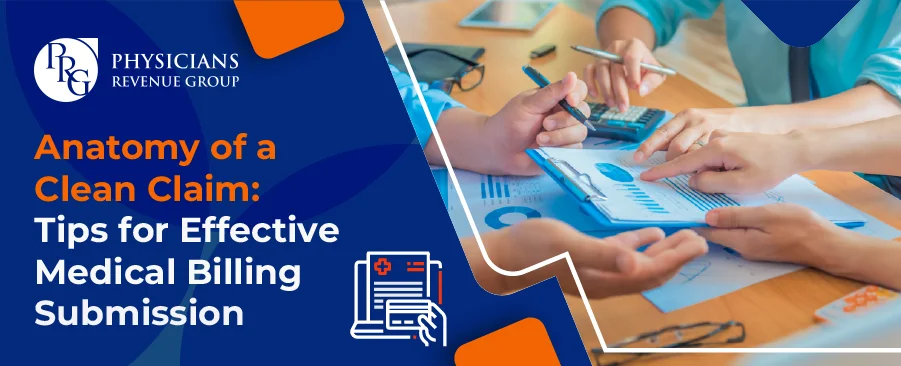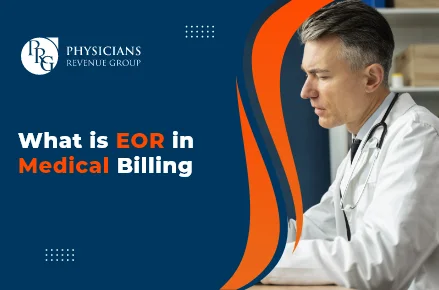
Email: info@prgmd.com | Call: +1 (630) 242-6474
Business hours: 9:00 to 5:00 | Monday to Friday
Email: info@prgmd.com | Call: +1 (630) 242-6474
Business hours: 9:00 to 5:00 | Monday to Friday

Table of Contents
ToggleThe strong anatomy of a clean claim solely depends on the careful and well-managed filing of the medical insurance claims. A clean claim must be without any discrepancies or other issues. These issues may include inadequate evidence, which can impede reimbursements. An indicator of flawless medical billing services is an increased Clean Claim Rate and the least claim resubmittals. What it implies is that the claim processes are accurate. A stronger anatomy of a clean claim serves as a cascading motion that sets up better accuracy of claims, resulting in a shorter payment time, less manual labor required, and lesser operational costs.
The clean claims work to raise the cash flow and overall revenue of your medical practice; however, what do these imply?
Let’s define a clean claim in medical billing and how to submit clean claims so you can submit them correctly the first time.
The anatomy of a clean claim depends on numerous elements; with these unaccounted for, inaccurate, or incomprehensible, the medical bills are turned down.
A clean claim must abide by the following criteria, including acknowledging the following:
What effects do clean claims have on healthcare practices?
A practice’s clean claims rate comes with a direct influence on the overall revenue. Unclear or troublesome coding and billing practices lead to claim denials or even delay payments, which in turn are devastating for medical practices. Many rejected claims are refiled multiple times without addressing or rectifying errors.
So, what can your practice do to ensure cleaner claims and least claim resubmittals?
Medical claims carry all important data/information regarding a patient’s visit to a facility or healthcare provider, including:
That said, this information may change from time to time. Invalid or incorrect information completely messes up the anatomy of a clean claim, thus resulting in rejections or denials.
Above are the reasons why keeping updated patient information is necessary for the health anatomy of a clean claim. It is essential to confirm and verify data/information before a patient’s visit, avoid delays in reimbursements, and ensure proper documentation. Correct and precise documentation plays an essential role in ensuring appropriate operations of medical billing.
Ideally, there are two types of patients for a healthcare provider, including:
It is important to note that one of the biggest reasons for fewer clean claims or higher claim denials is old or outdated insurance information. The medical staff or the management often assumes that the insurance information of established patients hasn’t changed. Staying on top of primary, secondary, and tertiary insurance information is essential to reach the 95% clean claim rate. This information must be confirmed and verified 5 days before the patient visit/procedure. Furthermore, some other things must also be confirmed, including:
In-depth and detailed documentation is another way to ensure a higher clean claim rate. Proper patient documentation includes all details of the following:
Proper, complete, and accurate documentation is vital to the medical billing process, as the biller has to translate the present information into codes. Incorrect or improper documentation leads to the use of wrong or inaccurate codes, resulting in imminent rejections and claim denials. Moreover, the patient information can also be periodically updated as a supplemental record.
Preparing for and submitting a medical insurance claim on time is complex, and there are specific guidelines for every payer. Such anatomy of a clean claim makes the process a rather complex one. The insurance payers’ coding guidelines may include compatibility between CPT and ICD, paper-based or electronic claims, and more. Not following the insurance-payer-specific guidelines and requirements results in rejections and claim denials.
To achieve a higher claim ratio, healthcare practices or providers must meet all requirements set forth by the payer while also keeping an eye on the claim submission deadlines. In an instance of finding a discrepancy in patient coverage, it is important to resolve the matter before submitting the claim to avoid denials.
The errors in healthcare coding can be human-made, including outdated, incorrect, deleted codes, or even a mix-up of alphabets or numbers. Such errors result in rejected or denied claims, bringing about a lesser clean claim rate. To ensure a high percentage of a clean claim rate, submitting error-free claims right in the first go is essential.
In addition to using correct codes, ensuring correct modifiers is also vital for ensuring an error-free claim submission. It is important to note that the modifiers are not supposed to alter the meaning of codes. The modifiers only provide additional information concerning the procedure or service performed. For this reason only, it becomes important to double-check and verify the modifier used in a claim. It is important to keep up with the official guidelines to ensure the correct use of modifiers. In addition to using a correct modifier, accurate usage of the modifier is also essential to maintain a strong anatomy of a clean claim.
Some common reasons for claim rejection in medical billing include:
Share:
Categories
Recently Added

What is an ABN in medical billing?

What does a Clearinghouse do During Claims Submission?

What is EOR in Medical Billing?
We Would Love to Assist You!
We treat your data confidentially and don’t share any information with a third party.